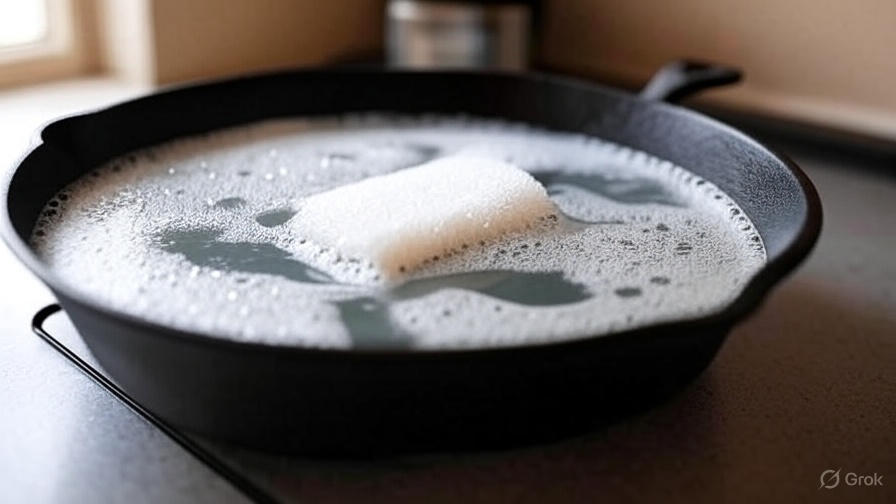How Can I Clean My Cast Iron Skillet
Cast iron skillets have earned their place as kitchen workhorses for good reason. These versatile pans deliver exceptional heat retention, create beautiful sears on meats, and develop a natural non-stick surface when properly maintained. However, many home cooks feel intimidated by cast iron care, especially when it comes to cleaning. The good news is that maintaining your cast iron skillet doesn’t require complicated techniques or expensive products.
This comprehensive guide will walk you through everything you need to know about cleaning cast iron cookware, from daily maintenance to deep cleaning methods. You’ll learn proven techniques that will keep your skillet in excellent condition for decades to come.
Why Cast Iron Cleaning Differs from Regular Cookware
Cast iron requires special care because of its unique properties. Unlike stainless steel or non-stick pans, cast iron is porous and reactive to moisture. The metal can rust quickly when exposed to water and air, which is why traditional dish soap and soaking methods can damage your pan.
The seasoning layer on your cast iron skillet acts as a protective barrier. This polymerized oil coating prevents rust and creates the coveted non-stick surface. Harsh cleaning methods can strip away this seasoning, leaving your pan vulnerable to corrosion and making food stick to the surface.
Essential Tools for Cast Iron Cleaning
Before diving into cleaning methods, gather these basic tools:
- Coarse salt or kosher salt
- Chainmail scrubber or cast iron scrubber
- Stiff-bristled brush
- Paper towels or clean cloth
- Cooking oil (vegetable oil, canola oil, or flaxseed oil)
- Plastic scraper or spatula
- Hot water
These simple tools will handle most cleaning situations you’ll encounter with your cast iron skillet.
Daily Cleaning Method: The Standard Approach
The best time to clean your cast iron skillet is immediately after cooking while the pan is still warm. This approach prevents food from hardening and makes cleanup significantly easier.
Start by scraping out any food debris with a plastic scraper or spatula. Don’t worry about getting every bit – you’ll address stubborn residue in the next steps.
Run the warm skillet under hot water. The temperature difference won’t crack your pan, and hot water helps dissolve grease and food particles more effectively than cold water.
Sprinkle coarse salt generously across the cooking surface. The salt acts as an abrasive that won’t damage the seasoning layer. Use a paper towel, cloth, or your hands to scrub the salt around the pan in circular motions.
For stubborn spots, use a chainmail scrubber or stiff brush. Apply gentle pressure and work the scrubber in small circles. The combination of salt and scrubbing action will remove most food residue without damaging the seasoning.
Rinse the pan thoroughly with hot water to remove all salt and debris. Inspect the surface to ensure all food particles are gone.
Drying and Re-seasoning After Cleaning
Water is cast iron’s biggest enemy, so proper drying is crucial. After rinsing, immediately dry the skillet completely with paper towels or a clean cloth. Don’t let the pan air dry, as this can lead to rust spots.
For extra protection, place the dried skillet on the stovetop over medium heat for 1-2 minutes. This evaporates any remaining moisture that might be trapped in the pan’s pores.
While the pan is still warm, apply a thin layer of cooking oil to the entire surface, including the bottom and handle. Use a paper towel to spread the oil evenly and wipe away any excess. The goal is a barely visible coating that won’t pool or feel greasy.
Heat the oiled pan for another minute to help the oil penetrate the metal. This quick re-seasoning step maintains the protective layer and prevents rust between uses.
Deep Cleaning for Heavily Soiled Pans
Sometimes your cast iron skillet needs more intensive cleaning. This might happen after cooking particularly sticky foods or if you’ve neglected regular maintenance.
Begin with the standard cleaning method described above. If food residue remains after the salt scrub, don’t panic. You have several options for deeper cleaning.
Create a paste using coarse salt and a small amount of neutral oil. This mixture provides more scrubbing power than salt alone. Work the paste into problem areas with a chainmail scrubber or stiff brush, applying steady pressure.
For extremely stubborn residue, try the deglazing method. Add a small amount of hot water to the warm pan and use a spatula to scrape up stuck-on food. The steam and heat will help loosen debris. Empty the water and continue with the salt scrub method.
If food is burned onto the surface, avoid the temptation to soak the pan. Instead, add enough hot water to cover the bottom and place the skillet on the stovetop. Bring the water to a simmer and use a spatula to gently scrape away the burned bits. This method uses steam and heat to loosen stubborn residue without damaging the seasoning.
Removing Rust from Cast Iron
Rust spots can appear on cast iron if it’s exposed to moisture for extended periods. Don’t despair – rust is treatable and won’t ruin your pan permanently.
For light rust spots, create a paste using coarse salt and a small amount of oil. Scrub the rusty areas with this paste using a chainmail scrubber or steel wool. The abrasive action will remove surface rust while the oil helps protect the metal.
More extensive rust requires aggressive treatment. Use fine steel wool or a wire brush to scrub away all rust spots. Work systematically across the entire surface, paying special attention to problem areas. This process will remove some seasoning, but you can rebuild it with proper care.
After removing rust, wash the pan with warm water and a small amount of mild dish soap. Yes, you can use soap on cast iron when necessary – this is one of the few situations where soap is appropriate. Dry the pan thoroughly and apply a thin coat of oil to prevent new rust from forming.
Dealing with Sticky Residue
Sticky residue on cast iron often results from cooking sugary foods or overheating oil. This buildup feels tacky to the touch and can make food stick to the pan.
Heat the affected pan on the stovetop over medium heat. As the pan warms, the sticky residue will begin to soften. Use a plastic scraper to gently remove the softened material.
For stubborn sticky spots, sprinkle coarse salt onto the warm pan and scrub with a chainmail scrubber. The combination of heat, salt, and scrubbing action will break down most sticky residues.
If the residue persists, try the oil and salt paste method. Create a thick paste and work it into the sticky areas with firm pressure. The oil will help dissolve the residue while the salt provides abrasive action.
The Soap Debate: When It’s Okay to Use Dish Soap
Traditional wisdom says never to use soap on cast iron, but modern dish soaps are much gentler than their predecessors. While you shouldn’t make soap a regular part of your cleaning routine, it’s acceptable in certain situations.
Use mild dish soap when your pan has been contaminated with raw meat juices or has developed an off smell. Apply a small amount to a sponge or cloth and gently clean the surface. Rinse thoroughly with hot water and dry immediately.
Soap is also appropriate when removing rust or when deep cleaning a neglected pan. After using soap, you’ll need to re-season the pan more thoroughly to restore the protective coating.
Maintaining Your Cast Iron Between Uses
Proper storage prevents many cleaning problems. Store your cast iron skillet in a dry location with good air circulation. Avoid stacking cast iron pieces directly on top of each other, as this can trap moisture and cause rust.
If you must stack cookware, place a paper towel or cloth between pieces to absorb any moisture. Some cooks prefer to store cast iron in the oven, as it’s typically a dry environment.
Regular use actually helps maintain cast iron seasoning. Each time you cook with oil or fat, you’re adding to the protective layer. Cook acidic foods sparingly, as they can break down seasoning over time.
Troubleshooting Common Cleaning Problems
Black residue on paper towels after cleaning usually indicates that the seasoning layer is flaking off. This isn’t necessarily a problem – it might just mean the seasoning is building up nicely. However, if large flakes are coming off, you may need to strip and re-season the pan.
Food sticking to the pan after cleaning suggests that the seasoning layer needs work. Cook fatty foods like bacon or sausage to help build up the non-stick surface. You can also perform a stovetop seasoning by heating the pan with a thin layer of oil until it begins to smoke.
White spots on cast iron typically indicate mineral deposits from hard water. These spots are harmless but can be removed with a vinegar solution. Mix equal parts water and white vinegar, apply to the spots, and scrub gently with a soft brush.
Building and Maintaining Seasoning
The seasoning layer is what makes cast iron special. This polymerized oil coating develops over time with proper use and care. Every time you cook with oil or fat, you’re contributing to this protective layer.
To accelerate seasoning development, cook foods high in fat. Bacon, sausage, and other fatty meats are excellent for building seasoning. The rendered fat coats the pan and polymerizes with heat, creating a smooth, non-stick surface.
You can also season your pan on the stovetop. Heat the clean, dry pan over medium heat and add a thin layer of oil. Heat until the oil begins to smoke, then turn off the heat and let the pan cool. This process can be repeated several times to build up the seasoning layer.
Long-term Care and Maintenance
Cast iron skillets can last for generations with proper care. The key is consistency – regular cleaning and maintenance prevent major problems from developing.
Inspect your pan regularly for signs of rust or damage. Catch problems early, and they’re much easier to fix. A small rust spot can be addressed with simple scrubbing, while extensive rust requires more intensive treatment.
Don’t be afraid to use your cast iron skillet regularly. These pans are designed to be workhorses, and frequent use actually helps maintain the seasoning layer. The more you cook with your skillet, the better it will perform.
When to Seek Professional Help
Most cast iron problems can be solved at home with patience and the right techniques. However, severe rust damage or cracks might require professional restoration or replacement.
If your pan has developed deep pits from rust or has cracks in the metal, it might be time to retire it. These structural problems can’t be fixed with home remedies and may affect the pan’s safety and performance.
Conclusion
Cleaning your cast iron skillet doesn’t have to be complicated or intimidating. The key is developing good habits and using the right techniques for different situations. Regular cleaning with salt and oil, proper drying, and light re-seasoning will keep your pan in excellent condition for years to come.
Remember that cast iron is forgiving. Even if you make mistakes or neglect your pan, it can usually be restored with patience and proper care. The investment in learning proper cast iron maintenance pays dividends in the form of superior cooking performance and a pan that will last a lifetime.
Start with the basic cleaning method and gradually build your confidence with more advanced techniques. Soon, caring for your cast iron skillet will become second nature, and you’ll wonder why you ever found it intimidating. Your properly maintained cast iron will reward you with decades of excellent cooking performance and delicious meals.







